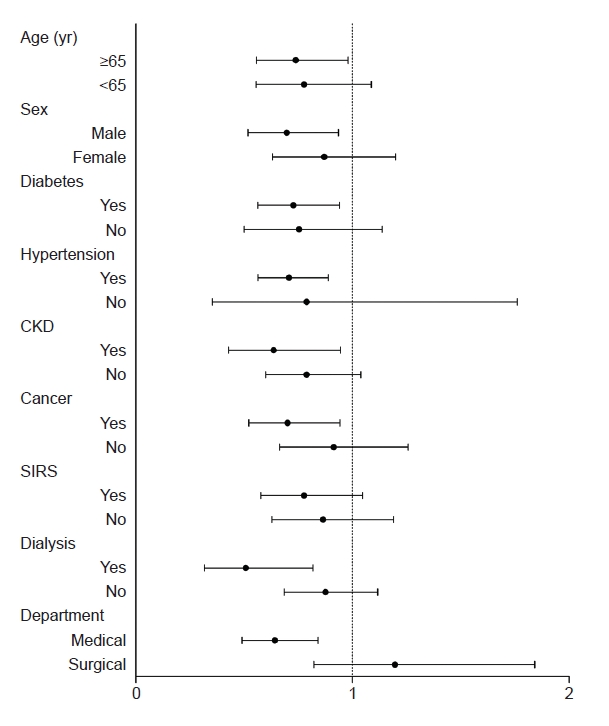1. Hoste EA, Clermont G, Kersten A, et al. RIFLE criteria for acute kidney injury are associated with hospital mortality in critically ill patients: a cohort analysis.
Crit Care 2006;10:R73.



2. Bagshaw SM, George C, Dinu I, Bellomo R. A multi-centre evaluation of the RIFLE criteria for early acute kidney injury in critically ill patients.
Nephrol Dial Transplant 2008;23:1203–1210.


3. Joannidis M, Metnitz B, Bauer P, et al. Acute kidney injury in critically ill patients classified by AKIN versus RIFLE using the SAPS 3 database.
Intensive Care Med 2009;35:1692–1702.



4. Gammelager H, Christiansen CF, Johansen MB, Tønnesen E, Jespersen B, Sørensen HT. One-year mortality among Danish intensive care patients with acute kidney injury: a cohort study.
Crit Care 2012;16:R124.



5. Hoste EA, Bagshaw SM, Bellomo R, et al. Epidemiology of acute kidney injury in critically ill patients: the multinational AKI-EPI study.
Intensive Care Med 2015;41:1411–1423.



6. Bellomo R, Kellum JA, Ronco C. Acute kidney injury.
Lancet 2012;380:756–766.


8. Chawla LS, Eggers PW, Star RA, Kimmel PL. Acute kidney injury and chronic kidney disease as interconnected syndromes.
N Engl J Med 2014;371:58–66.



9. Murugan R, Hoste E, Mehta RL, et al. Precision fluid management in continuous renal replacement therapy.
Blood Purif 2016;42:266–278.



10. Tolwani A, Mehta RL. Practical issues in the use of continuous renal replacement therapies (CRRT).
Semin Dial 2021;34:397.



11. Ostermann M, Lumlertgul N, Mehta R. Nutritional assessment and support during continuous renal replacement therapy.
Semin Dial 2021;34:449–456.



12. Rhee H, Berenger B, Mehta RL, Macedo E. Regional citrate anticoagulation for continuous kidney replacement therapy with calcium-containing solutions: a cohort study.
Am J Kidney Dis 2021;78:550–559.



13. Pakula AM, Skinner RA. Acute kidney injury in the critically ill patient: a current review of the literature.
J Intensive Care Med 2016;31:319–324.



15. Romagnoli S, Ricci Z, Ronco C. Perioperative acute kidney injury: prevention, early recognition, and supportive measures.
Nephron 2018;140:105–110.



16. Darmon M, Truche AS, Abdel-Nabey M, Schnell D, Souweine B. Early recognition of persistent acute kidney injury.
Semin Nephrol 2019;39:431–441.


17. Mehta RL, McDonald B, Gabbai F, et al. Nephrology consultation in acute renal failure: does timing matter?
Am J Med 2002;113:456–461.

18. Ponce D, Zorzenon Cde P, dos Santos NY, Balbi AL. Early nephrology consultation can have an impact on outcome of acute kidney injury patients.
Nephrol Dial Transplant 2011;26:3202–3206.


19. Zarbock A, Kellum JA, Schmidt C, et al. Effect of early vs delayed initiation of renal replacement therapy on mortality in critically ill patients with acute kidney injury: the ELAIN Randomized Clinical Trial.
JAMA 2016;315:2190–2199.


20. Gaudry S, Hajage D, Schortgen F, et al. Initiation Strategies for renal-replacement therapy in the intensive care unit.
N Engl J Med 2016;375:122–133.


21. Barbar SD, Clere-Jehl R, Bourredjem A, et al. Timing of renal-replacement therapy in patients with acute kidney injury and sepsis.
N Engl J Med 2018;379:1431–1442.


22. STARRT-AKI Investigators; Canadian Critical Care Trials Group; Australian and New Zealand Intensive Care Society Clinical Trials Group, et al. Timing of initiation of renal-replacement therapy in acute kidney injury.
N Engl J Med 2020;383:240–251.


23. Kellum JA, Romagnani P, Ashuntantang G, Ronco C, Zarbock A, Anders HJ. Acute kidney injury.
Nat Rev Dis Primers 2021;7:52.



25. Oh TK, Kim HG, Song IA. Epidemiologic study of intensive care unit admission in South Korea: a nationwide population-based cohort study from 2010 to 2019.
Int J Environ Res Public Health 2022;20:81.



26. Section 2: AKI definition.
Kidney Int Suppl (2011) 2012;2:19–36.



27. Mehta RL. Renal recovery after acute kidney injury and long-term outcomes: is time of the essence?
JAMA Netw Open 2020;3:e202676.



28. Duff S, Murray PT. Defining early recovery of acute kidney injury.
Clin J Am Soc Nephrol 2020;15:1358–1360.



30. Vincent JL, Moreno R, Takala J, et al. The SOFA (Sepsis-related Organ Failure Assessment) score to describe organ dysfunction/failure. On behalf of the Working Group on Sepsis-Related Problems of the European Society of Intensive Care Medicine.
Intensive Care Med 1996;22:707–710.



31. Levy MM, Fink MP, Marshall JC, et al. 2001 SCCM/ESICM/ACCP/ATS/SIS International Sepsis Definitions Conference.
Intensive Care Med 2003;29:530–538.



32. Murugan R, Kerti SJ, Chang CH, et al. Association of net ultrafiltration rate with mortality among critically ill adults with acute kidney injury receiving continuous venovenous hemodiafiltration: a secondary analysis of the randomized evaluation of normal vs augmented level (RENAL) of renal replacement therapy trial.
JAMA Netw Open 2019;2:e195418.



33. Ostermann M, Joannidis M, Pani A, et al. Patient selection and timing of continuous renal replacement therapy.
Blood Purif 2016;42:224–237.



34. Alghamdi MK, Alhozali HM, Bokhary OA, et al. Impact of early nephrology referral on the outcomes of patients with acute kidney injury.
Saudi J Med Med Sci 2022;10:221–226.



36. Macedo E, Malhotra R, Claure-Del Granado R, Fedullo P, Mehta RL. Defining urine output criterion for acute kidney injury in critically ill patients.
Nephrol Dial Transplant 2011;26:509–515.


37. Vaara ST, Parviainen I, Pettilä V, et al. Association of oliguria with the development of acute kidney injury in the critically ill.
Kidney Int 2016;89:200–208.










 PDF Links
PDF Links PubReader
PubReader ePub Link
ePub Link Full text via DOI
Full text via DOI Download Citation
Download Citation Supplement table 1
Supplement table 1 Print
Print















